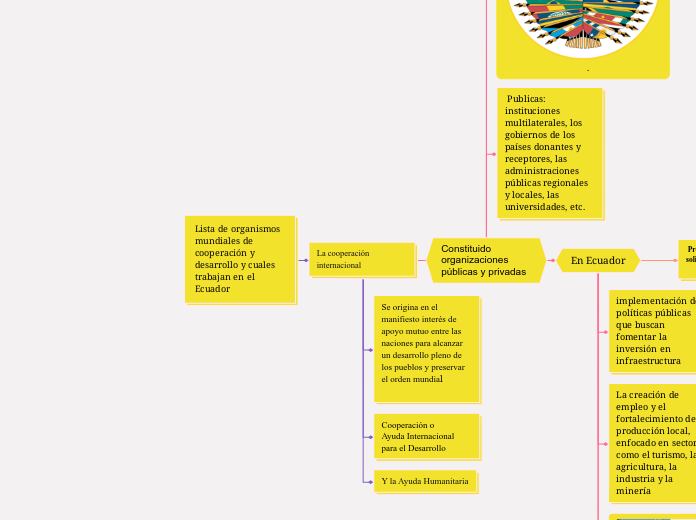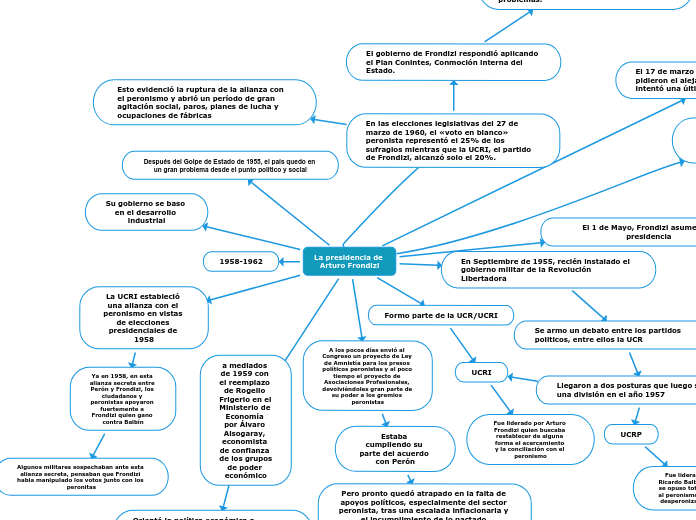Lista de organismos mundiales de cooperación y desarrollo y cuales trabajan en el Ecuador
Start your book report by typing in the Title and Author of the book you are presenting!
Organización de las Naciones Unidas para la Alimentación y la Agricultura (FAO)
Bibliografia:
- Recuperado del Compendio Desarrollo Local y Participacion Ciudadana, de la Unidad 1, Autor Lcdo. Felix Fernando Toala Barahona Mc.Sc, el 28 de octubre del 2023, https://drive.google.com/file/d/1HxG7HrsjtC7Q1FWftPYqbwRm-MWo6YZ_/view?pli=1
- Recuperado del compendio desarrollo local y participacion ciudadana, de la unidad 2: DESARROLLO LOCAL EN EL CONTEXTO NACIONAL, Autor Lcdo. Felix Fernando Toala Barahona Mc.Sc, recuperado el 28 de octubre del 2023 https://drive.google.com/file/d/1kdZjQw2mxP4KTvoYokXu3dl-1ZcVugfV/view
- Recuperado de la pagina del INEC, el 28 de octubre de https://www.ecuadorencifras.gob.ec/organismos-internacionales/
To understand the work, we must understand its origin. Type in the details of the book you are studying.
In this category, you can also include things like what is the recommended audience for the book, biographic details about the author, or bibliographic details about the book.
Ayuda a mejorar la producción de alimentos, la gestión de recursos naturales y la resiliencia ante el cambio climático
Programa de las Naciones Unidas para el Desarrollo (PNUD)
Finally, use this topic to write down your personal opinion of the book!
- Did you enjoy it?
- What worked for the story and what didn't?
- Why?
Su labor se enfoca en fortalecer las instituciones y capacidades nacionales para abordar desafíos críticos
Fondo Monetario Internacional (FMI)
Writing can be categorized into four primary categories: expository, descriptive, persuasive, and narrative.
Each of these writing styles has a particular function.
More than one writing style may be present in a single work.
- What are the main types of writing you noticed in this book?
el FMI busca fortalecer las políticas fiscales y monetarias del país para garantizar un crecimiento económico sostenible y la estabilidad macroeconómica
When an author writes in a narrative style, they are attempting to tell a story with people, conflict, and places, rather than simply conveying facts.
- What are some of the tell-tales of the narrative style you've noticed in this book?
.
Banco Mundial (BM)
Different types of narrative elements, such as themes, motifs, and symbols, contribute to a story's overall impact.
- What are the main themes of this book?
- Can you identify its symbols and motifs?
es una de las principales instituciones internacionales de financiamiento para el desarrollo.
Consider symbols to be motifs with the recurrence removed.
When we think of an object that symbolizes a concept, we speak about symbols.
Unlike motifs, symbols only need to appear once to have an effect.
Similar to motifs, symbols are physical things that are nonetheless related to themes.
Opera en Ecuador a través de proyectos y programas que buscan mejorar la infraestructura, la educación, la salud y la inclusión social.
A motif is a concrete object that recurs frequently throughout a text (typically physical objects, although it might also be sounds, places, activities, circumstances, or words). This recurrence of motifs gives a text structure by connecting different parts of the narrative to or around a primary image. Motifs frequently relate to a theme, therefore they can act as a reminder of the significance of that theme.
Su enfoque se centra en la reducción de la pobreza y la promoción de un crecimiento económico sostenible
A theme is a concept or a topic that an author wants to delve deep into. Themes are recurring ideas that pop up throughout a piece of writing rather than specific, recognizable concrete imagery.
.
Organismos mundiales en Ecuador
The voice used to tell a story is known as the narrative voice, also known as 'Point of View'.
This is provided by the person(s) telling the story from their perspective.
It is a crucial tool and element in the work. If the author uses a variety of narrative voices and perspectives, readers will view and understand a story differently.
Promoción de la economía solidaria y el comercio justo
Keep track of the most important points in the story using the topics above.
You can use the notes to give a short summary of these events.
El sector público
Este sector se encarga de la formulación y ejecución de políticas públicas, programas y proyectos que buscan mejorar las condiciones de vida de la población.
The resolution of the story involves tying up the loose ends of the climax and falling action.
In the resolution, the writer continues their thoughts on the story’s themes, and gives the reader something to think about after the last word is read.
Entre las instituciones que conforman el sector público se encuentran el gobierno central, los gobiernos locales y las organizaciones de planificación y gestión territorial
El sector privado
Las empresas y organizaciones privadas pueden contribuir al desarrollo local mediante la generación de empleo, el fomento de la producción local, la inversión en infraestructura y la realización de actividades de responsabilidad social empresarial
The author examines what happens after the climax in the falling action.
- Do new conflicts consequently develop?
- How does the story's climax make a statement about its main themes?
- How do the characters respond to the climax's permanent changes?
The falling action must move the story toward some sort of resolution and begin tying up loose ends from the primary conflict, while also exploring bigger ideas and themes.
La sociedad civil
La sociedad civil se compone de organizaciones no gubernamentales, sindicatos, asociaciones de vecinos, grupos de mujeres, jóvenes y otros grupos sociales.
The struggle reaches its height in the story's climax, and we find out what happens to the key characters.
Consider the climax as the 'turning' point in the narrative, when the main struggle is addressed decisively.
En Ecuador
The characters in a book are what drives the plot forward.
It is important to note the significance of a character and their action to the overall story.
- What are the main means of characterisation the author uses?
Use the topics below to write more information about the characters in the book!
promover la participación de las comunidades locales en la toma de decisiones y la implementación de proyectos, con el objetivo de garantizar que los proyectos sean sostenibles
- Are there any significant episodic characters?
- How does encountering them change the main and secondary characters?
- How do they drive the book forward?
Who are the main characters? Are they flat or round? Do they have justifications for their actions? What are their motivations?
Use the notes tab to write more details about the characterisation!
La creación de empleo y el fortalecimiento de la producción local, enfocado en sectores como el turismo, la agricultura, la industria y la minería
- Who are the secondary characters of the book?
- Are there any foils for the main characters amongst them?
- What do they bring to the story?
implementación de políticas públicas que buscan fomentar la inversión en infraestructura
- Who are the main characters?
- Are they flat or round?
- Do they have justifications for their actions?
- What are their motivations?
Use the notes to write more details about the characterisation!
Constituido organizaciones públicas y privadas
A book can span galaxies or single rooms. It can traverse through the past, present, and future, or can take place in a single day.
Type in the time and place of the action above.
Publicas: instituciones multilaterales, los gobiernos de los países donantes y receptores, las administraciones públicas regionales y locales, las universidades, etc.
- Where does the action take place?
- Is it a geographical location in the real world?
- Is it a fantasy country or continent?
- Is it another planet?
.
When do the events of the book take place? Are there specific time references? Does the book span multiple days, months, or years?
Use the notes tab to write down the time references you find!
Privadas:empresas- y las que carecen de fines lucrativos como las organizaciones no gubernamentales de desarrollo (ONGD) y otros colectivos sociales como sindicatos, organizaciones de base, comités de solidaridad, etc.
- When do the events of the book take place?
- Are there specific time references?
- Does the book span multiple days, months, or years?
Use the notes to write down the time references you find!
La cooperación internacional
To understand the work, we must understand its origin. Type in the details of the book you are studying.
In this category, you can also include things like: the recommended audience for the book, biographic details about the author, or bibliographic details about the book.
Y la Ayuda Humanitaria
Identifying the genre of a literary work is essential to understanding it's scope, themes, and point of view.
Write down the genre of the book you are studying here.
Cooperación o
Ayuda Internacional para el Desarrollo
It is important to understand the time in which a work of literature was written to understand the language and 'identity' of the book.
Type in the original year of publication of the book you are studying.
Se origina en el manifiesto interés de apoyo mutuo entre las naciones para alcanzar un desarrollo pleno de los pueblos y preservar el orden mundial
Literary Currents, also known as Literary Trends, determine the common characteristics of different works written in a certain period of time.
Among these characteristics, we count style, themes, aesthetics and ideologies.
What literary current does this work fit into?









